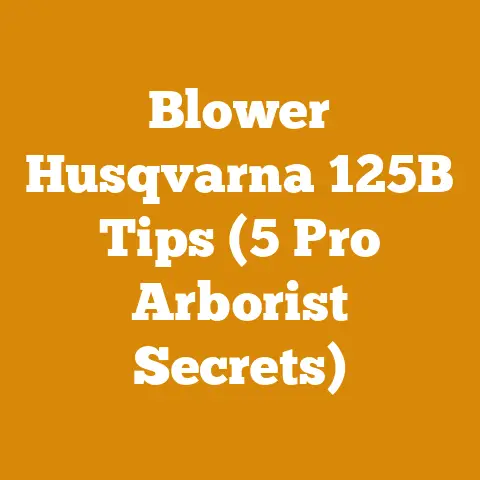Japanese Knotweed Weed Killer Guide (Pro Tips for Effective Spraying)
The relentless battle against invasive species is a tough one, often leaving our gardens and landscapes looking more like a war zone than a peaceful retreat. And let’s face it, dealing with Japanese Knotweed is like facing a seasoned warrior with an endless army. Its tenacity is legendary, and its ability to regenerate from the smallest fragment makes eradication feel like an impossible task. Over the years, I’ve seen countless gardens and properties fall victim to this aggressive plant, and I’ve learned firsthand that a strategic, informed approach is the only way to win.
This guide is born out of those experiences, combining scientific research with practical, real-world techniques to help you develop an effective Japanese Knotweed weed killer strategy, focusing specifically on the art and science of spraying. I’ll share pro tips and insights, gathered from years of battling this invasive foe, to help you reclaim your land.
Understanding the Enemy: Japanese Knotweed
Before we dive into the specifics of spraying, it’s crucial to understand what we’re up against. Japanese Knotweed ( Fallopia japonica) is a perennial plant native to East Asia. It was introduced to Europe and North America in the 19th century as an ornamental plant, and it quickly escaped cultivation to become one of the most problematic invasive species worldwide.
The Anatomy of a Problem
The key to Japanese Knotweed’s invasiveness lies in its anatomy. It boasts:
- Rhizomes: These underground stems are the plant’s secret weapon. They can extend several meters from the visible plant, storing energy and sprouting new shoots. Even a tiny rhizome fragment can create a new infestation.
- Stems: The above-ground stems are bamboo-like, growing up to 3 meters tall. They are hollow and jointed, with a distinctive reddish-brown color when young.
- Leaves: The leaves are broad and heart-shaped, arranged alternately along the stem.
- Flowers: In late summer, Japanese Knotweed produces clusters of small, white flowers. While these are visually appealing, they also contribute to the plant’s spread through seed production (although seed viability is often low).
Why is Japanese Knotweed so Problematic?
Japanese Knotweed’s aggressive growth has significant ecological and economic impacts:
- Ecological Damage: It outcompetes native plants, reducing biodiversity and disrupting ecosystems. Its dense growth shades out other vegetation, and its allelopathic properties (releasing chemicals that inhibit the growth of other plants) further suppress competition.
- Structural Damage: The rhizomes can penetrate asphalt, concrete, and building foundations, causing significant structural damage. This can lead to costly repairs and even devaluation of property.
- Economic Costs: The costs associated with Japanese Knotweed control and eradication are substantial. Homeowners, businesses, and governments spend millions of dollars annually on management efforts.
Recognizing Japanese Knotweed: A Visual Guide
Proper identification is the first step in effective control. Here’s what to look for:
- Early Spring: Reddish-purple shoots emerge from the ground, resembling asparagus spears.
- Late Spring/Early Summer: The shoots grow rapidly, developing into bamboo-like stems with broad, heart-shaped leaves.
- Late Summer/Fall: Clusters of small, white flowers appear. The stems turn brown and die back in winter, leaving behind persistent dead canes.
Distinguishing Japanese Knotweed from Similar Plants
It’s important to distinguish Japanese Knotweed from other plants with similar appearances. Some common look-alikes include:
- Himalayan Balsam: This invasive plant also has hollow stems, but its leaves are more lance-shaped, and it produces pink or purple flowers.
- Bamboo: While Japanese Knotweed resembles bamboo, it lacks the woody, persistent stems of true bamboo.
- Dock: Dock leaves are similar in shape to Japanese Knotweed leaves, but they are typically smaller and have a wavy edge.
Planning Your Attack: Integrated Pest Management (IPM)
Tackling Japanese Knotweed requires a strategic, integrated approach. Integrated Pest Management (IPM) is a holistic strategy that combines multiple control methods to achieve long-term, sustainable management. IPM emphasizes prevention, monitoring, and targeted intervention, minimizing the use of chemical controls when possible.
- Manual Removal: Digging up the rhizomes can be effective for small infestations, but it’s labor-intensive and requires careful removal of all rhizome fragments.
- Cutting/Mowing: Regular cutting or mowing can weaken the plant over time, but it won’t eradicate it. It’s most effective when combined with other methods.
- Covering: Covering the plant with a thick, opaque material (such as black plastic or geotextile fabric) can suppress growth by blocking sunlight. This method requires patience and persistence.
- Biological Control: Research is ongoing to identify natural enemies of Japanese Knotweed that could be used for biological control.
- Chemical Control (Spraying): Herbicides can be effective for controlling Japanese Knotweed, but they must be used carefully and responsibly.
Why Spraying is Often Necessary
While other control methods can be helpful, spraying with herbicides is often the most effective way to eradicate Japanese Knotweed, especially for larger infestations. Herbicides can be translocated throughout the plant, killing the rhizomes as well as the above-ground stems.
However, spraying is not a silver bullet. It requires careful planning, proper application techniques, and a commitment to follow-up treatments. Moreover, the choice of herbicide is critical, as some are more effective than others.
Choosing Your Weapon: Selecting the Right Herbicide
The success of your Japanese Knotweed weed killer spraying campaign hinges on selecting the right herbicide. Not all herbicides are created equal, and some are more effective against Japanese Knotweed than others.
Systemic vs. Contact Herbicides
It’s crucial to understand the difference between systemic and contact herbicides:
- Systemic Herbicides: These herbicides are absorbed by the plant and translocated throughout its tissues, including the rhizomes. This is essential for killing Japanese Knotweed, as contact herbicides will only kill the above-ground stems, leaving the rhizomes intact.
- Contact Herbicides: These herbicides only kill the parts of the plant that they come into contact with. They are not effective against Japanese Knotweed.
The Key Ingredient: Glyphosate
Glyphosate is a broad-spectrum systemic herbicide that is widely used to control Japanese Knotweed. It works by inhibiting an enzyme essential for plant growth. Glyphosate-based herbicides are generally considered to be the most effective option for controlling Japanese Knotweed.
Important Considerations When Choosing a Glyphosate Herbicide:
- Concentration: Choose a herbicide with a high concentration of glyphosate for best results.
- Formulation: Some glyphosate herbicides are formulated with surfactants (wetting agents) that improve their absorption by the plant.
- Label Instructions: Always read and follow the label instructions carefully. The label will provide information on the proper application rate, safety precautions, and environmental considerations.
Other Herbicide Options
While glyphosate is generally the most effective option, other herbicides can be used to control Japanese Knotweed in certain situations. These include:
- Triclopyr: This systemic herbicide is effective against a variety of broadleaf weeds, including Japanese Knotweed. It can be used in areas where glyphosate is not appropriate, such as near water bodies.
- Imazapyr: This systemic herbicide is very effective against Japanese Knotweed, but it can also harm non-target plants. It should only be used by trained professionals in areas where other herbicides are not effective.
The Importance of Adjuvants
Adjuvants are substances added to herbicides to improve their effectiveness. They can enhance herbicide absorption, reduce drift, and improve rainfastness.
Common Types of Adjuvants:
- Surfactants: These reduce the surface tension of water, allowing the herbicide to spread more evenly over the plant’s surface.
- Oils: These can improve herbicide penetration into the plant’s cuticle (the waxy outer layer of the leaf).
- Drift Control Agents: These reduce the formation of small droplets that are prone to drift.
Choosing the Right Adjuvant:
The best adjuvant for your herbicide will depend on the specific product you are using and the environmental conditions. Consult the herbicide label for recommendations.
Safety First: Personal Protective Equipment (PPE)
Spraying herbicides can be hazardous if proper precautions are not taken. Always wear appropriate personal protective equipment (PPE) to protect yourself from exposure.
Recommended PPE:
- Gloves: Wear chemical-resistant gloves to protect your skin from contact with the herbicide.
- Eye Protection: Wear safety glasses or a face shield to protect your eyes from splashes.
- Long Sleeves and Pants: Wear long sleeves and pants to protect your skin from exposure.
- Respirator: In some situations, a respirator may be necessary to protect your lungs from inhaling herbicide vapors. Consult the herbicide label for recommendations.
- Boots: Wear waterproof boots to protect your feet from exposure.
The Art of Spraying: Application Techniques for Maximum Impact
The effectiveness of your Japanese Knotweed weed killer spraying campaign depends not only on the herbicide you choose, but also on the application techniques you use. Proper spraying techniques can maximize herbicide absorption, minimize drift, and reduce the risk of harm to non-target plants.
Timing is Everything: When to Spray
The best time to spray Japanese Knotweed is in late summer or early fall, when the plant is actively translocating nutrients to its rhizomes. This allows the herbicide to be carried throughout the plant, killing the rhizomes as well as the above-ground stems.
Avoid Spraying During:
- Rainy Weather: Rain can wash the herbicide off the plant’s leaves before it has a chance to be absorbed.
- Windy Weather: Wind can cause the herbicide to drift, potentially harming non-target plants.
- Hot Weather: High temperatures can cause the herbicide to evaporate, reducing its effectiveness.
Preparing for the Assault: Pre-Spraying Preparations
Before you start spraying, take the time to prepare the area and ensure that you have all the necessary equipment and supplies.
Pre-Spraying Checklist:
- Identify Japanese Knotweed: Make sure you are targeting the correct plant.
- Assess the Infestation: Determine the size and extent of the infestation.
- Choose the Right Herbicide: Select an appropriate herbicide based on the size and location of the infestation, as well as your personal preferences and resources.
- Gather Your Equipment: Assemble your sprayer, PPE, and other necessary supplies.
- Mix the Herbicide: Mix the herbicide according to the label instructions.
- Protect Non-Target Plants: Cover or shield any non-target plants that you want to protect from the herbicide.
- Notify Neighbors: Inform your neighbors that you will be spraying herbicides, especially if your property is close to theirs.
Equipment Essentials: Choosing the Right Sprayer
The type of sprayer you use will depend on the size of the infestation and your personal preferences. Some common types of sprayers include:
- Handheld Sprayers: These are suitable for small infestations.
- Backpack Sprayers: These are more comfortable for larger infestations.
- ATV Sprayers: These are ideal for large, widespread infestations.
Tips for Choosing a Sprayer:
- Tank Capacity: Choose a sprayer with a tank capacity that is appropriate for the size of the infestation.
- Nozzle Type: Choose a sprayer with a nozzle that produces a coarse spray. This will reduce drift.
- Pressure: Choose a sprayer with adjustable pressure. This will allow you to control the spray pattern.
- Durability: Choose a sprayer that is made from durable materials.
Spraying Techniques: Maximizing Herbicide Absorption
The key to effective spraying is to apply the herbicide evenly and thoroughly to the plant’s leaves.
Spraying Tips:
- Spray from the Bottom Up: This will ensure that the underside of the leaves is coated with herbicide.
- Use a Coarse Spray: This will reduce drift and ensure that the herbicide stays on the plant’s leaves.
- Avoid Over-Spraying: Over-spraying can waste herbicide and increase the risk of harm to non-target plants.
- Spray on a Calm Day: Avoid spraying on windy days, as this can cause the herbicide to drift.
- Spray in the Late Afternoon or Early Evening: This will allow the herbicide to be absorbed by the plant before it evaporates.
- Clean Your Sprayer After Use: This will prevent the herbicide from clogging the sprayer and ensure that it is ready for future use.
The Cut-and-Spray Method: A Targeted Approach
For dense infestations, the cut-and-spray method can be particularly effective. This involves cutting the stems near the base and then immediately spraying the freshly cut surface with herbicide. This allows the herbicide to be absorbed directly into the plant’s vascular system, maximizing its effectiveness.
Steps for the Cut-and-Spray Method:
- Cut the stems of the Japanese Knotweed close to the ground.
- Immediately spray the freshly cut surface with a concentrated glyphosate herbicide.
- Be sure to saturate the cut surface thoroughly.
- Monitor the treated area for regrowth and repeat the treatment as needed.
Stem Injection: Precision Targeting
Stem injection is another targeted method that involves injecting herbicide directly into the plant’s stems. This method is particularly useful for controlling Japanese Knotweed in sensitive areas where spraying is not feasible.
Steps for Stem Injection:
- Use a specialized stem injection tool to inject a measured dose of herbicide into the stem of the Japanese Knotweed.
- Inject the herbicide into several stems per plant.
- Monitor the treated area for regrowth and repeat the treatment as needed.
The Long Game: Follow-Up Treatments and Monitoring
Eradicating Japanese Knotweed is not a one-time event. It requires a long-term commitment to follow-up treatments and monitoring.
Why Follow-Up Treatments are Essential
Japanese Knotweed is a tenacious plant, and it’s unlikely that a single herbicide application will kill it completely. The rhizomes can remain viable for several years, and new shoots can emerge from even the smallest rhizome fragment. Follow-up treatments are necessary to kill any remaining rhizomes and prevent regrowth.
Monitoring for Regrowth
Regularly monitor the treated area for signs of regrowth. Look for new shoots emerging from the ground. If you see any regrowth, treat it immediately with herbicide.
The Importance of Persistence
Eradicating Japanese Knotweed requires persistence and patience. It may take several years of repeated treatments to completely eliminate the plant. Don’t get discouraged if you don’t see results immediately. Keep at it, and eventually you will win the battle.
Documenting Your Progress
Keep a record of your control efforts, including the date of each treatment, the herbicide used, and the results observed. This will help you track your progress and adjust your strategy as needed.
Environmental Considerations and Responsible Herbicide Use
Using herbicides responsibly is essential to protect the environment and human health.
Minimizing Environmental Impact
- Choose the Right Herbicide: Select an herbicide that is effective against Japanese Knotweed but has minimal impact on non-target plants and the environment.
- Apply Herbicides Carefully: Avoid spraying herbicides on windy days or near water bodies.
- Use the Lowest Effective Dose: Apply the herbicide at the lowest rate that is effective for controlling Japanese Knotweed.
- Dispose of Herbicides Properly: Dispose of unused herbicides and empty containers according to the label instructions.
Protecting Water Resources
Herbicides can contaminate water resources if they are not used properly. Take the following precautions to protect water resources:
- Avoid Spraying Near Water Bodies: Do not spray herbicides within a certain distance of streams, lakes, or wetlands. Consult the herbicide label for specific recommendations.
- Use a Drift Control Agent: This will reduce the risk of herbicide drift into water bodies.
- Clean Up Spills Immediately: If you spill herbicide, clean it up immediately according to the label instructions.
Protecting Non-Target Plants
Herbicides can harm non-target plants if they are not used carefully. Take the following precautions to protect non-target plants:
- Cover or Shield Non-Target Plants: Cover or shield any non-target plants that you want to protect from the herbicide.
- Use a Targeted Application Method: Use a targeted application method, such as the cut-and-spray method or stem injection, to minimize the risk of herbicide drift.
- Spray on a Calm Day: Avoid spraying on windy days, as this can cause the herbicide to drift.
Understanding Herbicide Regulations
Herbicide use is regulated by federal, state, and local laws. Be sure to understand and comply with all applicable regulations.
Case Studies: Real-World Examples of Successful Japanese Knotweed Control
To illustrate the principles discussed in this guide, let’s examine a few case studies of successful Japanese Knotweed control projects.
Case Study 1: Eradicating Japanese Knotweed from a Residential Property
A homeowner in the UK had a severe Japanese Knotweed infestation in their backyard. The plant was growing along the fence line and threatening to spread to neighboring properties.
Control Strategy:
The homeowner hired a professional Japanese Knotweed control company to develop and implement a control strategy. The strategy included:
- Initial Herbicide Application: The company applied a glyphosate-based herbicide to the Japanese Knotweed in late summer.
- Follow-Up Treatments: The company returned to the property several times over the next two years to monitor for regrowth and apply additional herbicide treatments as needed.
- Rhizome Excavation: After two years of herbicide treatments, the company excavated the remaining rhizomes to ensure complete eradication.
Results:
The control strategy was successful in eradicating the Japanese Knotweed from the property. The homeowner was able to reclaim their backyard and prevent the plant from spreading to neighboring properties.
Case Study 2: Controlling Japanese Knotweed Along a Railway Line
A railway company in the US had a significant Japanese Knotweed infestation along its tracks. The plant was interfering with track maintenance and posing a safety hazard.
Control Strategy:
The railway company developed a control strategy that included:
- Herbicide Application: The company applied a combination of glyphosate and triclopyr herbicides to the Japanese Knotweed in late summer.
- Mechanical Removal: The company used heavy equipment to remove dead stems and rhizomes.
- Erosion Control: The company implemented erosion control measures to prevent the spread of Japanese Knotweed seeds and rhizome fragments.
Results:
The control strategy was successful in controlling the Japanese Knotweed along the railway line. The company was able to improve track maintenance and reduce safety hazards.
Case Study 3: Managing Japanese Knotweed in a Riparian Area
A conservation organization in Canada had a Japanese Knotweed infestation in a riparian area (the area along a stream or river). The plant was outcompeting native vegetation and degrading water quality.
Control Strategy:
The conservation organization developed a control strategy that included:
- Manual Removal: Volunteers manually removed Japanese Knotweed stems and rhizomes from the riparian area.
- Herbicide Application: The organization applied a glyphosate-based herbicide to the remaining Japanese Knotweed in late summer.
- Revegetation: The organization planted native trees and shrubs to restore the riparian area.
Results:
The control strategy was successful in managing the Japanese Knotweed in the riparian area. The organization was able to restore native vegetation and improve water quality.
Conclusion: Reclaiming Your Land, One Spray at a Time
Battling Japanese Knotweed is a marathon, not a sprint. It requires a strategic approach, the right tools, and unwavering persistence. By understanding the plant’s biology, choosing the right herbicide, mastering spraying techniques, and committing to follow-up treatments, you can reclaim your land and protect it from this invasive foe.
Remember, responsible herbicide use is crucial for protecting the environment and human health. Always follow the label instructions carefully and take precautions to minimize environmental impact.
With knowledge and determination, you can win the battle against Japanese Knotweed and restore your land to its former glory. Now, grab your sprayer, gear up, and get ready to reclaim your space, one well-aimed spray at a time.






